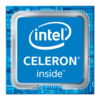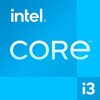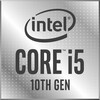Intel Celeron 5305U vs Intel Core i3-1215U vs Intel Core i5-10210U
Intel Celeron 5305U
► remove from comparison
The Intel Celeron 5305U is a low-power dual-core SoC for laptops, based on the Comet Lake architecture, which was introduced in 2020. Compared to Kaby Lake and Whiskey Lake, there are apparently no differences with Comet Lake apart from the two additional cores in the Top model Core i7-10710U. The processor is still manufactured using the mature 14nm process (14nm++ like Whiskey Lake). The processor cores clock at a fixed 2.3 GHz (no Turbo) and also only offer 2 threads (no HyperThreading). Compared to the more powerful Core i3, i5 and i7 variants, the Celeron does not offer SSE (2) support.
You can find more information about the Comet Lake architecture and the available processors on our Comet Lake topic page.
According to Intel, the integrated graphics card is called Intel UHD Graphics, but is an old Intel UHD Graphics 610. It is clocked in the Celeron 5205U at 300 - 900 MHz and is only sufficient for very demanding games. The CPU also offers an integrated DDR4-2666 / LPDDR4x 2933 / LPDDR3-2133 dual-channel memory controller as well as VP9 and H.265 video decoder and encoder.
Performance
The performance of the Celeron 5305U is in the lowest entry-level class of notebook processors in 2020. Due to the lack of Turbo and only 2 cores, the CPU cannot score points in either single-core or multi-core tasks. The processor is therefore only suitable for undemanding tasks such as surfing with a few tabs and office tasks.
The power consumption and performance can be set from 15 to 12.5 watts by the notebook manufacturer via cTDP-down. However, the processor then only runs at 800 MHz and significantly reduced performance. Even at 15 watts, however, the processor is suitable for thin and light notebooks.
Intel Core i3-1215U
► remove from comparison
The Intel Core i3-1215U is a mid-range mobile CPU for thin and light laptops based on the Alder Lake architecture. It was announced in early 2022 and offers 2 performance cores (P-cores, Golden Cove architecture) and 4 efficient cores (E-cores, Gracemont architecture). The P-cores support Hyper-Threading leading to 8 supported threads when combined with the E-cores. The clock rate ranges from 1.2 to 4.4 GHz on the performance cluster and 0.9 to 3.3 GHz on the efficient cluster. The performance of the E-cores should be similar to old Skylake cores (compare to the Core i7-6700HQ). All cores can use up to 10 MB L3-cache. Compared to the faster i5 and i7 models, the i3 does not include vPro features.
Performance
The average 1215U in our database is in the same league as the Ryzen 3 5300U and also the Core i7-1185G7, as far as multi-thread benchmark scores are concerned. This is decent enough of a result, as of late 2022. For an entry-level CPU, that is.
Your mileage may vary depending on how competent the cooling solution of your laptop is, and how high the CPU power limits are.
Features
The integrated memory controller supports various memory types up to DDR5-4800, DDR4-3200, LPDDR5-5200, and LPDDR4x-4267. The Thread Director (in hardware) can support the operating system to decide which thread to use on the performance or efficient cores for the best performance. For AI tasks, the CPU also integrates GNA 3.0 and DL Boost (via AVX2). Quick Sync in version 8 is the same as in the Rocket Lake CPUs and supports MPEG-2, AVC, VC-1 decode, JPEG, VP8 decode, VP9, HEVC, and AV1 decode in hardware. The CPU only supports PCIe 4.0 (x8 for a GPU and two x4 for SSDs).
The integrated graphics card is based on the Xe-architecture and offers 64 of the 96 EUs (Execution Units) operating at up to 1.1 GHz.
The CPU is rated at 15 W base power (TDP, PL1) and 55 W max. Turbo power (PL2) and the whole SoC is manufactured in a 10nm process at Intel, which is known as Intel 7.
Intel Core i5-10210U
► remove from comparison
The Intel Core i5-10210U is a power efficient quad-core SoC for notebooks based on the Comet Lake (CML-U) generation and was announced in August 2019. Compared to the similar Whiskey Lake processors (e.g. Core i5-8665U), the only difference is support for higher memory speeds (up to LPDDR4-2933 vs DDR4-2400) and two additional cores in the top model (not in this i5). The processor cores are clocked between 1.6 and 4.2 GHz (all 4 cores 3.9 GHz max). Thanks to Hyper-Threading 8 threads can be used. Compared to the faster i5-10510U, the level 3 cache was reduced from 8 to 6 MB. More information on Comet Lake and all the models and articles on it can be found here.
The integrated graphics adapter however is still the same as in the previous generations. It's still called Intel UHD Graphics 620 and clocked from 300 - 1100 MHz in the i5. Furthermore, the SoC integrates a VP9 and H.265 de- and encoder.
Performance
The average 10210U in our database is just as fast as the AMD Ryzen 5 2500U, the Intel Core i7-8565U and the Intel Core i5-1035G1 are, as far as multi-thread benchmark scores are concerned. While the i5 is not a performance monster, it sails through basic day-to-day workloads with little effort.
Thanks to its decent cooling solution and a long-term power limit of 30 W, the Frost Canyon NUC (NUC10i5FNK) is among the fastest systems powered by the 10210U that we know of. It can be more than twice as fast in CPU-bound workloads as the slowest system featuring the same chip in our database, as of August 2023.
Power consumption
This Core i5 series chip has a default TDP, also known as the long-term power limit, of 15 W, a value that laptop makers are free to change to anything between 10 W and 25 W with clock speeds and performance changing accordingly as a result. By going for the lowest value, it is possible to build a passively cooled system around the i5. Please note that Comet Lake-U processors can briefly consume as much as 80 W or even 90 W when under heavy loads.
The Core i5-10210U is built with one of the old 14 nm Intel processes for very low, as of mid 2023, energy efficiency.
| Model | Intel Celeron 5305U | Intel Core i3-1215U | Intel Core i5-10210U | ||||||||||||||||||||||||||||||||||||||||||||||||||||||||||||||||||||||||||||||||||||||||||||||||||||||||||||||||||||||||||||||||||||||||
| Codename | Comet Lake-U | Alder Lake-U | Comet Lake-U | ||||||||||||||||||||||||||||||||||||||||||||||||||||||||||||||||||||||||||||||||||||||||||||||||||||||||||||||||||||||||||||||||||||||||
| Series | Intel Comet Lake | Intel Alder Lake-M | Intel Comet Lake | ||||||||||||||||||||||||||||||||||||||||||||||||||||||||||||||||||||||||||||||||||||||||||||||||||||||||||||||||||||||||||||||||||||||||
| Series: Comet Lake Comet Lake-U |
|
|
| ||||||||||||||||||||||||||||||||||||||||||||||||||||||||||||||||||||||||||||||||||||||||||||||||||||||||||||||||||||||||||||||||||||||||
| Clock | 2300 MHz | 900 - 4400 MHz | 1600 - 4200 MHz | ||||||||||||||||||||||||||||||||||||||||||||||||||||||||||||||||||||||||||||||||||||||||||||||||||||||||||||||||||||||||||||||||||||||||
| Cores / Threads | 2 / 2 | 6 / 8 | 4 / 8 | ||||||||||||||||||||||||||||||||||||||||||||||||||||||||||||||||||||||||||||||||||||||||||||||||||||||||||||||||||||||||||||||||||||||||
| TDP | 15 Watt | 15 Watt | 15 Watt | ||||||||||||||||||||||||||||||||||||||||||||||||||||||||||||||||||||||||||||||||||||||||||||||||||||||||||||||||||||||||||||||||||||||||
| Technology | 14 nm | 10 nm | 14 nm | ||||||||||||||||||||||||||||||||||||||||||||||||||||||||||||||||||||||||||||||||||||||||||||||||||||||||||||||||||||||||||||||||||||||||
| max. Temp. | 100 °C | 100 °C | 100 °C | ||||||||||||||||||||||||||||||||||||||||||||||||||||||||||||||||||||||||||||||||||||||||||||||||||||||||||||||||||||||||||||||||||||||||
| Socket | BGA1528 | BGA1744 | BGA1528 | ||||||||||||||||||||||||||||||||||||||||||||||||||||||||||||||||||||||||||||||||||||||||||||||||||||||||||||||||||||||||||||||||||||||||
| Features | LPDDR3-2133/DDR4-2400 RAM, PCIe 2, 4 GT/s bus, MMX, SSE, SSE2, SSE3, SSSE3, SSE4.1, SSE4.2, AVX, AVX2, BMI2, ABM, FMA, ADX, VMX, SMEP, SMAP, MPX, EIST, TM1, TM2, SST, AES-NI, RDRAND, RDSEED, SGX | DDR4-3200/LPDDR4x-4266/DDR5-4800/LPDDR5-5200 RAM, PCIe 4, Thr. Dir., DL Boost, GNA, MMX, SSE, SSE2, SSE3, SSSE3, SSE4.1, SSE4.2, AVX, AVX2, BMI2, ABM, FMA, ADX, SMEP, SMAP, EIST, TM1, TM2, HT, Turbo, SST, AES-NI, RDRAND, RDSEED, SHA | LPDDR3-2133/DDR4-2666/LPDDR4-2933 RAM, PCIe 3, 4 GT/s bus, MMX, SSE, SSE2, SSE3, SSSE3, SSE4.1, SSE4.2, AVX, AVX2, BMI2, ABM, FMA, ADX, VMX, SMEP, SMAP, MPX, EIST, TM1, TM2, Hyper-Threading, Turbo, SST, AES-NI, RDRAND, RDSEED, SGX | ||||||||||||||||||||||||||||||||||||||||||||||||||||||||||||||||||||||||||||||||||||||||||||||||||||||||||||||||||||||||||||||||||||||||
| iGPU | Intel UHD Graphics 610 (300 - 900 MHz) | Intel UHD Graphics 64EUs (Alder Lake 12th Gen) ( - 1100 MHz) | Intel UHD Graphics 620 (300 - 1100 MHz) | ||||||||||||||||||||||||||||||||||||||||||||||||||||||||||||||||||||||||||||||||||||||||||||||||||||||||||||||||||||||||||||||||||||||||
| Architecture | x86 | x86 | x86 | ||||||||||||||||||||||||||||||||||||||||||||||||||||||||||||||||||||||||||||||||||||||||||||||||||||||||||||||||||||||||||||||||||||||||
| $107 U.S. | |||||||||||||||||||||||||||||||||||||||||||||||||||||||||||||||||||||||||||||||||||||||||||||||||||||||||||||||||||||||||||||||||||||||||||
| Announced | |||||||||||||||||||||||||||||||||||||||||||||||||||||||||||||||||||||||||||||||||||||||||||||||||||||||||||||||||||||||||||||||||||||||||||
| Manufacturer | ark.intel.com | ark.intel.com | ark.intel.com | ||||||||||||||||||||||||||||||||||||||||||||||||||||||||||||||||||||||||||||||||||||||||||||||||||||||||||||||||||||||||||||||||||||||||
| L1 Cache | 544 KB | 256 KB | |||||||||||||||||||||||||||||||||||||||||||||||||||||||||||||||||||||||||||||||||||||||||||||||||||||||||||||||||||||||||||||||||||||||||
| L2 Cache | 5 MB | 1 MB | |||||||||||||||||||||||||||||||||||||||||||||||||||||||||||||||||||||||||||||||||||||||||||||||||||||||||||||||||||||||||||||||||||||||||
| L3 Cache | 10 MB | 6 MB |
Benchmarks
Average Benchmarks Intel Celeron 5305U → 0% n=0
Average Benchmarks Intel Core i3-1215U → 0% n=0
Average Benchmarks Intel Core i5-10210U → 0% n=0
* Smaller numbers mean a higher performance
1 This benchmark is not used for the average calculation













